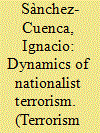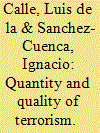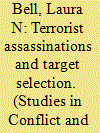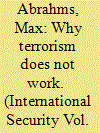| Srl | Item |
| 1 |
ID:
080342


|
|
|
|
|
| Publication |
2007.
|
| Summary/Abstract |
Nationalist terrorism aspires to independence or greater autonomy for some territory. The combination of territorial claims and armed struggle gives rise to a very definite strategy, violence intended to coerce the State. Nationalist terrorist organizations kill repeatedly with the aim of breaking the will of the State. They engage in a peculiar sort of war of attrition with the State. This paper analyzes comparatively the war of attrition strategy in two organizations, ETA and the IRA. The focus of the paper is on strategy: it examines how ETA and the IRA understood their activity in terms of war of attrition and how they developed their strategy subject to some constraints, such as the moderate preferences of their supporters. I show that popularity constraints account for the high degree of selectivity in their killings. The analysis is based on a combination of historical information, internal documents, and a large data set I have constructed of the killings of these two organizations.
|
|
|
|
|
|
|
|
|
|
|
|
|
|
|
|
| 2 |
ID:
175731


|
|
|
|
|
| Summary/Abstract |
Although there has recently been a considerable increase in research into lone actor terrorism, one of the main areas that remains understudied is that of target selection. The lack of empirically driven studies that can guide prevention measures is a notable oversight. This paper applies methods from environmental criminology to examine the residence-to-attack journeys of 122 lone terrorist acts in the U.S and Europe. The distance decay effect was evident, and significant differences were found between subgroups. Individuals were more likely to travel further if a) they were in the U.S, b) they had links to a wider network, c) they had a single-issue ideology, d) they attacked an iconic target, e) they attacked a symbolic building, or f) they used a bomb as their main weapon. A few case studies are discussed which highlight a need to conduct further research that considers the whole nodal network of an individual. The findings suggest that distance can be put forward as a constraining factor on lone actor target selection and provide support for the notion that the spatial decision making of terrorists is similar to traditional criminals.
|
|
|
|
|
|
|
|
|
|
|
|
|
|
|
|
| 3 |
ID:
102508


|
|
|
|
|
| Publication |
2011.
|
| Summary/Abstract |
This article presents a dataset of fatalities of domestic terrorism in Western European countries for the period 1965-2005. The Domestic Terrorism Victims (DTV) dataset, unlike others such as TWEED or GTD1, is based on local sources in each country and, consequently, it registers a higher number of killings. Measurement of the quantity of terrorism is therefore more accurate. The unit of observation is the fatality, not the attack, although the data can be transformed in terms of lethal attacks. Detailed information about each killing has been collected, making it possible to create new variables about the quality of violence: target selection, selectivity of the killings and their strategic aim. The ideology of the terrorists generates interesting variation in these three variables. The DTV is particularly suitable for hypothesis testing on the quantity and quality of terrorism.
|
|
|
|
|
|
|
|
|
|
|
|
|
|
|
|
| 4 |
ID:
156153


|
|
|
|
|
| Summary/Abstract |
This research note examines political institutional changes in the aftermath of terrorist assassinations. Contemporary assassinations are more often a component of wider campaigns of political violence rather than a singular attack on a head of state. The Global Terrorism Database counts 16,831 terrorist assassinations from 1970–2014, indicating significant frequency of these events and includes a wide range of targets from law enforcement officials to foreign diplomats. Utilizing survival analysis, the span of time from a terrorist assassination event to a change in political institutions within states is measured between target types. Outcome differences between target types are identified.
|
|
|
|
|
|
|
|
|
|
|
|
|
|
|
|
| 5 |
ID:
074629


|
|
|
|
|
| Publication |
2006.
|
| Summary/Abstract |
This is the ªrst article to analyze a large sample of terrorist groups in terms of their policy effectiveness. It includes every foreign terrorist organization (FTO) designated by the U.S. Department of State since 2001. The key variable for FTO success is a tactical one: target selection. Terrorist groups whose attacks on civilian targets outnumber attacks on military targets do not tend to achieve their policy objectives, regardless of their nature. Contrary to the prevailing view that terrorism is an effective means of political coercion, the universe of cases suggests that, ªrst, contemporary terrorist groups rarely achieve their policy objectives and, second, the poor success rate is inherent to the tactic of terrorism itself. The bulk of the article develops a theory for why countries are reluctant to make policy concessions when their civilian populations are the primary target.
|
|
|
|
|
|
|
|
|
|
|
|
|
|
|
|